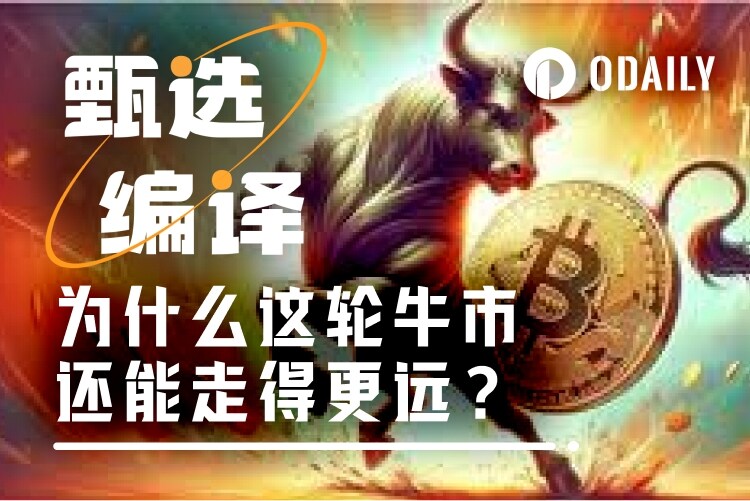The Liquidity Pyramid : Why This Bull Market Still Has Legs
Compiled by: Odaily Planet Daily Asher ( @Asher_0210 )

Editor's Note: The summer bull market of 2025 will be significantly different from previous ones. Funding is no longer primarily dependent on policy injections from the Federal Reserve or the Treasury, but rather driven by equity returns and record capital expenditures from large technology giants. This capital is channeled through innovative mechanisms such as corporate treasuries (TCOs) and exchange-traded funds (ETFs), gradually channeling into the crypto market, creating a self-reinforcing flywheel effect. This article will delve into this mechanism, analyze the shifting buyer structure of ETH and BTC, and provide a market outlook based on the macroeconomic environment and policy factors.
Despite the Fed's tightening policy and waning fiscal stimulus, risk assets have continued to surge, driven by two overlapping chains. First, AI-driven capital gains and record capital spending by large tech giants have been channeled through salaries, supplier payments, and shareholder dividends, continuously injecting risk capital into the crypto market. Second, crypto corporate treasuries (TCo) have established a new transmission mechanism, directly converting the reflexive frenzy of the stock market into on-chain buying, thus forming a self-reinforcing market flywheel.
This flywheel effect not only resists seasonal weakness and macro noise but also continues to propel the market higher until top corporate capital spending retreats or ETF demand stalls. In other words, this bull market is driven by liquidity created by large public companies, not traditional monetary or fiscal policies.
Shifting liquidity sources and new crypto buyers
Traditionally, market liquidity has relied on the Federal Reserve or the Treasury, but current liquidity has shifted. Equity gains and over $100 billion in capital expenditures by tech giants like Nvidia and Microsoft are radiating across the economy, impacting not only suppliers and employees but also driving retail investors to increase their holdings in risky assets, particularly the crypto market.
At the same time, a new structural buyer has emerged in the crypto market: corporate treasuries (TCOs). In past cycles, a lack of large buyers contributed to the sharp price fluctuations. However, corporate treasuries for BTC and ETH now not only serve as a funding bridge but also defend key price ranges and drive price breakthroughs. Corporate treasuries can be divided into two generations: early TCOs were price-insensitive and merely served as a floor; newer ETH-related TCOs have a price-seeking function, proactively buying when equity value accelerates, thus completing a self-contained cycle: additional corporate equity issuances generate capital, which TCOs purchase as reserve assets, driving up token prices. Simultaneously, the value of the parent company's shares held by the TCOs increases, reducing financing costs, and then investing again in the crypto market, repeating the cycle.
It’s important to note that this mechanism is not risk-free. If ETFs or retail investors fail to fill the key price range, a gap may appear in the middle, causing the token price to fall rapidly. Short-term fluctuations still warrant vigilance.
Structural changes in Ethereum
The ETH market has significantly changed from previous cycles. While previously buyers were primarily retail investors and miners, ETFs and TCOs have now become the dominant force in the market, working together to combat liquidity gaps. A new market narrative has emerged, driven by defensive price ranges and periodic buying.
From a technical analysis perspective, this phenomenon can be understood using the "cup theory": prices initially form a low point (the bottom of the cup) within a specific range, then slowly recover (the rim), forming an overall U-shaped trend. When prices break through the rim, it typically signals the potential for further market growth. In the Ethereum market, corporate treasuries focus on defending the $3,000 to $3,500 price range, while ETFs buy in phases in the gaps between them, like filling the cup with water, giving prices a chance to successfully break through the rim and continue their upward trend.
If tech companies maintain strong demand for ETH, this rally has room to continue; if demand is insufficient, the market could experience a brief lull and pullback. Overall, this shift in the buyer structure means Ethereum no longer relies solely on retail investors or miners, but is now supported by institutions and corporate coffers, making the market more stable and paving the way for continued price increases.
The dual driving forces of the macro environment and capital expenditure of technology giants
In the current market environment, macroeconomic factors and AI development are intertwined to influence economic and market trends. US commodity prices have risen for several consecutive months, with implied inflation at approximately 4%, indicating continued price pressures. Despite this, the Federal Reserve may still tolerate a certain degree of inflation to support economic growth, assuming the overall labor market remains stable. However, the persistently high youth underemployment rate is often seen as a warning sign of the early stages of an economic cycle. Younger groups are often the first to feel economic fluctuations. If employment conditions persist, the overall labor market could come under pressure, impacting risky assets as well.
Capital expenditures by tech giants are becoming a significant source of market liquidity. Hyperscale tech companies are making massive investments in AI infrastructure, which not only funds suppliers, employees, and shareholder dividends but also has the potential to significantly boost the economy's total factor productivity over the medium and long term. If the productivity gains from AI meet expectations, the US public debt-to-GDP ratio is expected to fall from a baseline of 156% to approximately 113% by 2055, with per capita GDP also expected to increase by approximately 17%. However, it's important to note that historical experience shows that the productivity effects of technological innovation typically lag, and the market tends to discount these future gains in advance, which in part explains the current high valuations of the stock market and crypto assets.
At the same time, trade policy uncertainty and tariff pressure are changing corporate investment behavior. Faced with a complex international trade environment and policy ambiguity, many companies are preferring to invest in financialized assets rather than long-term capital expenditures such as plants, equipment, or expansion projects. This preference for short-term capital flows into asset markets has, to a certain extent, supported the rise in risky assets, creating a structural backdrop for a bull market driven by private sector liquidity.
Investment Strategy
Investment strategies should prioritize AI-focused compounding stocks among high-quality tech giants, while also selectively investing in infrastructure sectors such as computing power, power, and networking. In the crypto market, Bitcoin can serve as a benchmark asset for risk exposure, while Ethereum acts as a self-reinforcing flywheel. Key price defensive ranges and potential gaps require careful attention. Regarding risk management, attention should be paid to ETF inflows and outflows, corporate treasury funding arrangements, and capital expenditure plans of large tech companies. While it's acceptable to moderately increase positions within key defensive ranges, cautiously reduce positions if a breakout lacks subsequent support.
Overall, this bull market is significantly different from the 2021 cycle. The current upward momentum stems primarily from private sector liquidity driven by large tech companies. These companies are releasing capital through equity returns and capital expenditures, which flows to suppliers, employees, shareholders, and retail investors. This capital is then transmitted to the crypto market through corporate treasuries and ETF structures, creating a self-reinforcing market flywheel. Key price ranges are supported by defensive and periodic buying from corporate treasuries, while ETFs and retail investors fill the gaps, maintaining market momentum. As long as tech giants continue to actively invest capital and this private sector liquidity chain remains unimpeded, the bull market has room to extend further.
- 核心观点:本轮牛市由科技巨头流动性驱动。
- 关键要素:
- 科技巨头资本开支注入加密市场。
- 企业财库TCo形成自我强化飞轮。
- ETH/BTC买家结构转向机构主导。
- 市场影响:加密市场稳定性提升。
- 时效性标注:中期影响。



